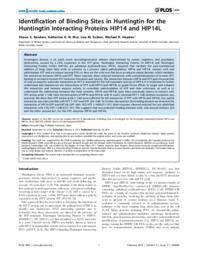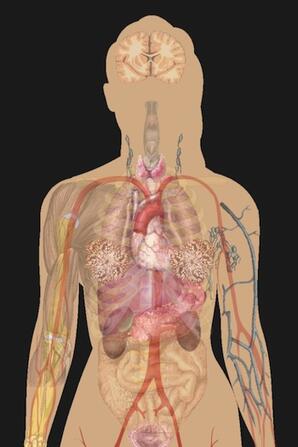Sutton, Liza M.
Person Preferred Name
Liza Sutton
Position
Faculty Member
Field of Activity
Neurodegenerative Diseases
Department
Status
current
Affiliation Date
2014-01
Education and Credentials
PhD (University College London, UK)
Douglas College Faculty member since 2014
PhD (University College London, UK)
Douglas College Faculty member since 2014
Related Works
Content type
Digital Document
Abstract
Prion diseases are neurodegenerative disorders affecting both animals and humans. They may be sporadic, infectious or genetic in origin. Variant CJD (vCJD) is a novel form of human prion disease, experimentally proven to be acquired from the consumption of bovine prion- infected material. The causative transmissible agent of prion disease is thought to consist predominantly of an abnormal isoform of the host-encoded prion protein (PrP(), designated PrPs\ To date, most prion research has been undertaken in animal models since transmitting the disease in cell culture has proved difficult. Nevertheless, a number of prion-propagating mammalian cell lines do exist but despite world-wide effort, no cell lines have shown susceptibility to human prion infection. The aim o f this thesis was to develop a cell line that stably propagated vCJD prions.
First, a high-throughput screening methodology for detection of human prions in cells was established. This involved subcloning of vCJD prion-infected cell lines, in order to isolate a rare susceptible clone, followed by detection o f PrP^ using the scrapie cell assay or cell blot assay. A panel of cell lines was selected to best mimic in vivo disease and screened for susceptibility to vCJD prion infection, but mammalian neuroblastoma, neuroglial, and epithelial cell lines were unable to stably propagate human prions. Transient vCJD prion propagation (between one and six passages) was observed in two human neuroblastoma lines (SKN-SH and SHSY5Y) and a rabbit epithelial kidney line (RK13) overexpressing human PrPc. Attempts to prolong prion propagation in a human neuroblastoma cell line with retroviral infection, to mimic the intercellular spread of prions via exosomes, were unsuccessful. The second approach involved the humanisation of a mouse prion-propagating cell line, N2a. To eliminate dominant-negative inhibition of human prion propagation by murine PrPc, the endogenous PrPc was knocked-out using RNAi technology. Greater than 90% murine PrPc knockout was achieved in several N2a-derived lines and exogenous expression o f mouse PrPc demonstrated that these cells were still susceptible to mouse prion infection. Human PrPc was subsequently expressed in these murine PrPc knockout lines to various levels. Following infection with vCJD prions, no long-term vCJD prion propagation was observed in these lines. A single murine PrPc knockout line overexpressing human PrP1 (two-fold) transiently propagated vCJD prions but this was not stable. The third approach used a v-myc immortalised human foetal neural stem cell (NSC) line derived from human ventral mesencephalon (ReNcell 197VM). These undifferentiated 197 cells were resistant to vCJD prion infection. Upon differentiation, the 197 cultures acquired a neuronal phenotype. Infection with a purified vCJD prion-infected brain homogenate yielded propagation o f vCJD prions in these differentiated human neurons for >40 days in vitro. This work has improved understanding of the complex factors underlying cellular susceptibility to prion infection. The primary human neuronal model will be invaluable for the study of the pathophysiology of human prion disease.
Origin Information
Content type
Digital Document
Abstract
Huntington disease (HD) is caused by polyglutamine expansion in the huntingtin (HTT) protein. Huntingtin-interacting protein 14 (HIP14), one of 23 DHHC domain-containing palmitoyl acyl transferases (PATs), binds to HTT and robustly palmitoylates HTT at cysteine 214. Mutant HTT exhibits reduced palmitoylation and interaction with HIP14, contributing to the neuronal dysfunction associated with HD. In this study, we confirmed that, among 23 DHHC PATs, HIP14 and its homolog DHHC-13 (HIP14L) are the two major PATs that palmitoylate HTT. Wild-type HTT, in addition to serving as a palmitoylation substrate, also modulates the palmitoylation of HIP14 itself. In vivo , HIP14 palmitoylation is decreased in the brains of mice lacking one HTT allele ( hdh +/−) and is further reduced in mouse cortical neurons treated with HTT antisense oligos (HTT-ASO) that knockdown HTT expression by ∼95%. Previously, it has been shown that palmitoylation of DHHC proteins may affect their enzymatic activity. Indeed, palmitoylation of SNAP25 by HIP14 is potentiated in vitro in the presence of wild-type HTT. This influence of HTT on HIP14 activity is lost in the presence of CAG expansion. Furthermore, in both brains of hdh +/− mice and neurons treated with HTT-ASO, we observe a significant reduction in palmitoylation of endogenous SNAP25 and GluR1, synaptic proteins that are substrates of HIP14, suggesting wild-type HTT also influences HIP14 enzymatic activity in vivo . This study describes an important biochemical function for wild-type HTT modulation of HIP14 palmitoylation and its enzymatic activity.
Origin Information
Content type
Digital Document
Abstract
Palmitoylation, the dynamic post-translational addition of the lipid, palmitate, to proteins by Asp-His-His-Cys-containing palmitoyl acyltransferase (PAT) enzymes, modulates protein function and localization and plays a key role in the nervous system. Huntingtin-interacting protein 14 (HIP14), a well-characterized neuronal PAT, has been implicated in the pathogenesis of Huntington disease (HD), a fatal neurodegenerative disease associated with motor, psychiatric and cognitive symptoms, caused by a CAG expansion in the huntingtin gene (HTT). Mice deficient for Hip14 expression develop neuropathological and behavioural features similar to HD, and the catalytic activity of HIP14 is impaired in HD mice, most likely due to the reduced interaction of HIP14 with HTT. Huntingtin-interacting protein 14-like (HIP14L) is a paralog of HIP14, with identical domain structure. Together, HIP14 and HIP14L are the major PATs for HTT. Here, we report the characterization of a Hip14l-deficient mouse model, which develops adult-onset, widespread and progressive neuropathology accompanied by early motor deficits in climbing, impaired motor learning and reduced palmitoylation of a novel HIP14L substrate: SNAP25. Although the phenotype resembles that of the Hip14(-/-) mice, a more progressive phenotype, similar to that of the YAC128 transgenic mouse model of HD, is observed. In addition, HIP14L interacts less with mutant HTT than the wild-type protein, suggesting that reduced HIP14L-dependent palmitoylation of neuronal substrates may contribute to the pathogenesis of HD. Thus, both HIP14 and HIP14L may be dysfunctional in the disease.
Origin Information
Content type
Digital Document
Abstract
Huntington disease is an adult onset neurodegenerative disease characterized by motor, cognitive, and psychiatric dysfunction, caused by a CAG expansion in the HTT gene. Huntingtin Interacting Protein 14 (HIP14) and Huntingtin Interacting Protein 14-like (HIP14L) are palmitoyl acyltransferases (PATs), enzymes that mediate the post-translational addition of long chain fatty acids to proteins in a process called palmitoylation. HIP14 and HIP14L interact with and palmitoylate HTT and are unique among PATs as they are the only two that have an ankyrin repeat domain, which mediates the interaction between HIP14 and HTT. These enzymes show reduced interaction with and palmitoylation of mutant HTT, leading to increased mutant HTT inclusion formation and toxicity. The interaction between HIP14 and HTT goes beyond that of only an enzyme–substrate interaction as HTT is essential for the full enzymatic activity of HIP14. It is important to further understand and characterize the interactions of HTT with HIP14 and HIP14L to guide future efforts to target and enhance this interaction and increase enzyme activity to remediate palmitoylation of HTT and their substrates, as well as to understand the relationship between the three proteins. HIP14 and HIP14L have been previously shown to interact with HTT amino acids 1–548. Here the interaction of HIP14 and HIP14L with N- and C-terminal HTT 1–548 deletion mutations was assessed. We show that HTT amino acids 1–548 were sufficient for full interaction of HTT with HIP14 and HIP14L, but partial interaction was also possible with HTT 1–427 and HTT 224–548. To further characterize the binding domain we assessed the interaction of HIP14-GFP and HIP14L-GFP with 15Q HTT 1-548D257-315. Both enzymes showed reduced but not abolished interaction with 15Q HTT 1-548D257-315. This suggests that two potential binding domains exist, one around residues 224 and the other around 427, for the PAT enzymes HIP14 and HIP14L.
Origin Information
Content type
Digital Document
Abstract
Huntington disease (HD) is an adult-onset neurodegenerative disease characterized by motor, cognitive, and psychiatric symptoms that is caused by a CAG expansion in the HTT gene. Palmitoylation is the addition of saturated fatty acids to proteins by DHHC palmitoylacyl transferases. HTT is palmitoylated by huntingtin interacting proteins 14 and 14-like (HIP14 and HIP14L or ZDHHC17 and 13 respectively). Mutant HTT is less palmitoylated and this reduction of palmitoylation accelerates its aggregation and increases cellular toxicity. Mouse models deficient in either Hip14 (Hip14−/−) or Hip14l (Hip14l−/−) develop HD-like phenotypes. The biological function of HTT palmitoylation and the role that loss of HTT palmitoylation plays in the pathogenesis of HD are unknown. To address these questions mice deficient for both genes were created. Loss of Hip14 and Hip14l leads to early embryonic lethality at day embryonic day 10–11 due to failed chorioallantoic fusion. The chorion is thickened and disorganized and the allantois does not fuse correctly with the chorion and forms a balloon-like shape compared to Hip14l−/−; Hip14+/+ littermate control embryos. Interestingly, the Hip14−/− ; Hip14−/− embryos share many features with the Htt−/− embryos, including folding of the yolk sac, a bulb shaped allantois, and a thickened and disorganized chorion. This may be due to a decrease in HTT palmitoylation. In Hip14−/−; Hip14l−/− mouse embryonic fibroblasts show a 25% decrease in HTT palmitoylation compared to wild type cells. This is the first description of a double PAT deficient mouse model where loss of a PAT or multiple PATs results in embryonic lethality in mammals. These results reinforce the physiological importance of palmitoylation during embryogenesis.
Origin Information
Content type
Digital Document
Abstract
Post-translational modification of proteins by the lipid palmitate is critical for protein localization and function. Palmitoylation is regulated by the opposing enzymes palmitoyl acyltransferases (PATs) and acyl protein thioesterases, which add and remove palmitate from proteins, respectively. Palmitoylation is particularly important for a number of processes including neuronal development and synaptic activity in the central nervous system. Dysregulated palmitoylation contributes to neuropsychiatric disease. In total six PATs (HIP14, HIP14L, ZDHHC8, ZDHHC9, ZDHHC12, and ZDHHC15) and one thioesterase (PPT1) have been implicated in Huntington disease (HD), Alzheimer disease, schizophrenia, mental retardation, and infantile and adult onset forms of neuronal ceroid lipofuscinosis. Currently there is no genetic link between PATs and Alzheimer disease pathogenesis but palmitoylation of amyloid precursor protein-processing enzyme, γ-secretase, influences β-amyloid generation. Several lines of evidence point to a role for palmitoylation by HIP14 in the pathogenesis of HD; HIP14 is dysfunctional in the presence of the HD mutation and Hip14-deficient mice develop features of HD. Wildtype huntingtin (the protein mutated in HD) enhances the PAT activity of HIP14 and mutant HTT interacts less with HIP14. Therefore, it may be that loss of the positive modulation of HIP14 activity due to reduced interaction with huntingtin is important in the disease mechanism. Preliminary evidence suggests a closely related PAT to HIP14, HIP14L, may also play a role in the pathogenesis of HD. In order to design rational therapeutic approaches to restore palmitoylation in neuropsychiatric disease, it will be critical to better understand the relationships between PATs and thioesterases with their regulators and substrates.
Origin Information
Content type
Digital Document
Abstract
Huntington disease (HD) is a neurodegenerative disorder caused by an elongated polyglutamine tract in huntingtin (htt). htt normally undergoes different posttranslational modifications (PTMs), including phosphorylation, SUMOylation, ubiquitination, acetylation, proteolytic cleavage, and palmitoylation. In the presence of the HD mutation, some PTMs are significantly altered and can result in changes in the clinical phenotype. A rate-limiting PTM is defined as one that can result in significant effects on the phenotype in animal models. For example, the prevention of proteolysis at D586 as well as constitutive phosphorylation at S13 and S16 can obviate the expression of phenotypic features of HD. The enzymes involved in these modifications such as caspase-6, the IκB kinase (IKK) complex, and still to be characterized phosphatases therefore represent promising therapeutic targets for HD. Identifying and testing specific modulators of PTMs now constitute the next big challenges in order to further validate these targets and proceed towards the goal of a mechanism-based treatment for HD.
Origin Information
Content type
Digital Document
Abstract
This textbook is a project under development by our Biology faculty to ultimately provide students with all the factual information they need to succeed in the BIOL 1203 and BIOL 1209 courses at Douglas College in BC, Canada. It was developed initially as an adaptation of the OpenStax Anatomy & Physiology textbook, freely available online at http://cnx.org/content/col11496/latest/. The original adaptations of that OpenStax textbook for Douglas College are accessible online at https://pressbooks.bccampus.ca/dcbiol11031109/ and https://pressbooks.bccampus.ca/dcbiol12031209/ In the first edition of the Douglas College adaptations the chapter and section numbers were left as they were in the version of the OpenStax A&P textbook, from which they were largely drawn. However, this second edition has been more extensively edited and rearranged to correspond with the curriculum used at Douglas College, so chapter and section numbers are no longer aligned specifically with the OpenStax A&P textbook.
Origin Information




